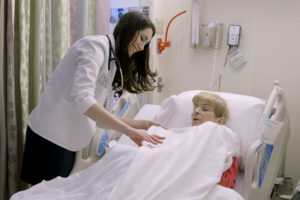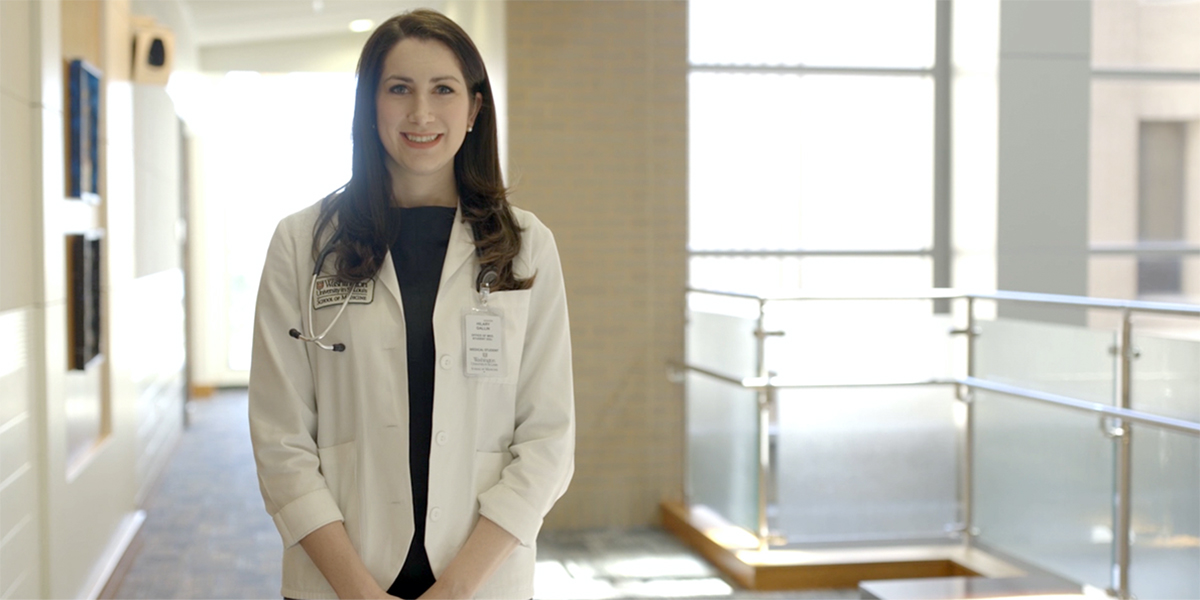During her first year at Washington University School of Medicine in St. Louis, Hilary Gallin studied racial and gender disparities in health care. She learned about various physicians’ approaches to community and global medicine. During overviews of medical specialties — from pediatrics to gerontology — Gallin learned about age-specific patient care.
However, she felt one important element was missing in her medical education.
“I kept thinking about people with chronic disabilities, whether physical or cognitive,” said Gallin, who will earn her medical degree in May. “And I kept asking myself if I, as a physician, would have the knowledge and skills to best treat a patient with disabilities.”
Her answer was no.
“I also asked myself if, as a physician, I would have access to specialized exam equipment and other resources,” Gallin said.
She didn’t know the answer to that question. The topic wasn’t formally included in medical school training.
Feeling she’d be unprepared as a physician, Gallin decided to create a multiyear curriculum for the School of Medicine that focused on treating patients with disabilities. According to research published in 2016 in the journal Academic Medicine, most medical schools do not offer formal training in caring for people with disabilities; rather, disability often is viewed as an obstacle to overcome, and health-care providers sometimes discount disability’s social, emotional and cultural contexts.
However, physicians nationwide, including at Washington University, say medical schools have started recognizing the need for training students to effectively and compassionately treat patients with disabilities. Some medical schools have implemented various degrees of disability education or have begun the process of considering or developing a disability curriculum.
Gallin witnessed firsthand the struggles facing people with disabilities. The 29-year-old grew up with a friend who navigated life in a wheelchair due to cerebral palsy, an incurable disorder caused by abnormal brain development, often before birth, that impairs motor function. Also, while a young girl, Gallin spent a lot of time in hospitals in her native New York while shadowing her mother, a pediatric ophthalmologist.
“These experiences inspired me to learn more about what I can do, what we can do, to help people with disabilities,” said Gallin, who also is earning a master of business administration this May from Harvard University and formerly worked as an investment banker at Goldman, Sachs & Co. on Wall Street. She believes business skills will make her a better doctor by guiding her through all aspects of the changing health-care system.
“I want to approach medicine from different angles instead of limiting myself to the clinical and research perspective,” said Gallin, whose undergraduate degree in biomedical engineering from Yale University provides an even deeper understanding of the industry as a whole. “A lot of major policy affecting health care is made without a physician in the room.”
Developing a disability curriculum
Academics aside, Gallin values considering patients’ personal backgrounds in evaluation and treatment. For instance, she imagined herself giving a medical exam to her friend with cerebral palsy. She wondered: “How would I weigh her? Would I need a special exam table? What’s it like to go to the doctor when you have a disability?”
So she asked her friend and other people with disabilities. Their insights reflected national findings that people with disabilities often feel that their overall abilities, self-knowledge about their conditions and quality of life are underestimated by health-care providers. Many felt embarrassed to discuss disability-related health concerns such as treating pressure sores or practicing safe sex.
“Physicians may assume the person is not sexually active, and that may not be the case,” said Gallin, who was elected by classmates and faculty to the Gold Humanism Honor Society, which honors those who exhibit compassion in medicine.
“Another example occurred when I was working on cervical cancer screenings, or pap smears, with the National Health Service in the United Kingdom,” Gallin said. “One primary-care physician cited that people with disabilities have lower screening rates, and he admitted that he didn’t feel competent in screening some patients due to lack of training. Physician lack of knowledge increases the risk for negative health outcomes.”
Indeed. “In the medical literature, physician education is cited as a source of health discrepancies in patients with disabilities,” Gallin said. “Formal training in medical school would help to remedy disability as a health disparity.”
A few weeks after Gallin started medical school, she sought guidance on developing a disability curriculum from one of her mentors, Alan I. Glass, MD, assistant vice chancellor for students and director of the Habif Health & Wellness Center, which offers student health services at Washington University.
“Because of her focus, passion and persistence, the project evolved into a mission within the medical school to better care for this large and important population,” Glass said. “Hilary’s work has become an important part of the diversity curriculum for medical students. It serves as a model for other schools.”
For the White House, too. Gallin discussed her curriculum with a representative from the Office for Public Engagement for the White House.

“In developing the curriculum, I reached out to leaders to learn what they thought was needed in physician education,” Gallin said. “It was around the 25th anniversary of the Americans with Disabilities Act, and the White House representative was curious to learn about what medical schools were doing to improve the care of people with disabilities.”
Washington University’s curriculum continues to evolve and improve, Gallin said.
“What is unique about the School of Medicine’s curriculum is that it builds on itself over time,” she said. “Students at other medical schools may receive informal training during their third year or attend isolated curriculum events over the year.
“But with our curriculum, students begin during the first year and continue throughout their studies,” she said. “They must demonstrate mastery of material through exams or standardized patient encounters, which is when an actor plays the role of patient and the student is scored based on performance.”
Gallin said she will continue to advocate for patients with disabilities — as well as all patients — when she begins her post-graduation residency in anesthesiology at the Harvard-affiliated Massachusetts General Hospital.
“One of a physician’s greatest assets is curiosity,” Gallin said. “With each person I treat, I will ask myself, ‘What are the preconceived assumptions that could hinder patient care?’”
Read more about the Class Acts of 2017 here.
